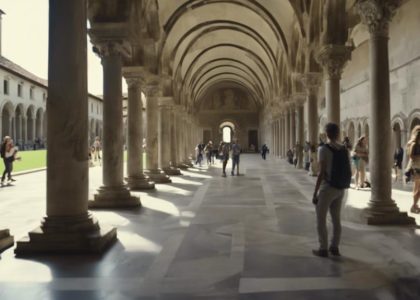The Camposanto Monumentale in Pisa stands as a testament to the rich history and artistic heritage of the region. Over time, this monumental cemetery has faced numerous restoration challenges due to its age and exposure to the elements. To ensure the preservation of its intricate stone carvings, delicate frescoes, and marble sculptures, experts have developed specialized techniques for cleaning and restoration. By understanding these best practices, conservators can effectively revitalize this historical site, uncovering its true beauty while safeguarding its cultural significance for generations to come.
Historical Significance of Camposanto Monumentale

Nestled within the iconic city of Pisa, the Camposanto Monumentale holds a profound historical significance that spans centuries. Built in the 13th century, this monumental cemetery is not only a resting place for the departed but also a testament to the rich cultural heritage of Pisa. The Camposanto Monumentale, with its impressive Gothic architecture, serves as a symbol of the city's resilience and enduring spirit.
Throughout its history, the Camposanto Monumentale has stood witness to various significant events, embodying the passage of time and the evolution of Pisa. From serving as a sacred burial ground for the city's elite to surviving damage during World War II, this site encapsulates the struggles and triumphs of the people of Pisa.
As visitors walk through the hallowed halls of the Camposanto Monumentale, they are met with a sense of reverence and awe, connecting them to the past and instilling a deep appreciation for the freedoms that we enjoy today. This historical landmark stands as a reminder of the enduring legacy of Pisa and the importance of preserving our shared history for future generations.
Common Restoration Challenges Faced

Restoration projects at the Camposanto Monumentale in Pisa frequently encounter a variety of common challenges that require careful consideration and expertise. One of the primary challenges faced during restoration efforts is the presence of atmospheric pollutants that have accumulated on the stone surfaces over centuries. These pollutants, such as soot, dirt, and biological growth, can significantly deteriorate the appearance and structural integrity of the monument if not properly addressed.
Another common challenge is the natural weathering processes that have affected the stone materials used in construction. This includes erosion, cracking, and staining due to exposure to rain, wind, and sunlight. Restorers must develop specialized techniques to mitigate these effects while preserving the historical authenticity of the monument.
Additionally, the accumulation of salts within the stone from previous restoration attempts poses a significant restoration challenge. These salts can cause efflorescence, a white powdery residue on the surface, which requires delicate removal techniques to avoid further damage to the stone.
Addressing these common challenges with precision and expertise is crucial to ensuring the successful restoration and preservation of the Camposanto Monumentale in Pisa.
Best Practices for Stone Cleaning

What are the most effective methods for cleaning stone surfaces during restoration projects at Camposanto Monumentale in Pisa? When it comes to restoring the historical stone surfaces at Camposanto Monumentale in Pisa, employing the best practices for stone cleaning is essential. Various techniques can be utilized to ensure the preservation and rejuvenation of the intricate stonework. One common method is gentle abrasive cleaning, which involves using mild abrasives to remove dirt and grime without damaging the stone's surface. Chemical cleaning agents can also be used, but it is crucial to select products that are specifically designed for historic stone conservation to prevent any harm.
To provide a clearer understanding, the table below outlines some of the best practices for stone cleaning during restoration projects at Camposanto Monumentale in Pisa:
| Method | Description | Benefits |
|---|---|---|
| Gentle Abrasive Cleaning | Mild abrasives used to remove dirt and grime | Preserves stone surface integrity |
| Chemical Cleaning Agents | Selective use of products designed for historic stone | Effective removal of tough stains |
| Steam Cleaning | Utilizes high-temperature steam for gentle cleaning | Environmentally friendly approach |
Techniques for Fresco Restoration

When considering techniques for fresco restoration at Camposanto Monumentale in Pisa, employing specialized methods tailored to the delicate nature of frescoes is paramount. Frescoes are intricate artworks painted directly onto wet plaster, making them vulnerable to damage over time. Restorers utilize meticulous approaches to ensure the preservation of these historical treasures.
One common technique is the consolidation of the fresco surface. This process involves stabilizing the layers of plaster and pigment to prevent further flaking or deterioration. Consolidation materials are carefully selected to match the original components of the fresco, ensuring compatibility and long-term protection.
Another crucial method is cleaning the fresco surface. Restorers use gentle solvents and tools to remove layers of dirt, grime, and previous restoration attempts without harming the original paint layers. This meticulous cleaning process reveals the true colors and details of the fresco, bringing it back to its former glory.
Preservation of Marble Sculptures

Specialized techniques are essential for ensuring the long-term preservation of marble sculptures at Camposanto Monumentale in Pisa, complementing the meticulous approaches employed in fresco restoration. The preservation of marble sculptures involves a combination of preventive measures and targeted interventions to maintain the integrity of these valuable artistic pieces. Here are four key strategies for effectively preserving marble sculptures:
- Regular Cleaning: Implementing a routine cleaning schedule using gentle methods to remove surface dirt and prevent the accumulation of debris that can degrade the marble over time.
- Consolidation Treatments: Applying consolidants to strengthen fragile or deteriorated areas of the marble, enhancing its structural stability and preventing further damage.
- Monitoring Environmental Conditions: Conducting regular assessments of temperature, humidity levels, and light exposure to identify and address any factors that could impact the sculptures' preservation.
- Protective Coatings: Applying suitable protective coatings to create a barrier against pollutants, UV radiation, and other external agents that could harm the marble surfaces, helping to prolong their lifespan.





